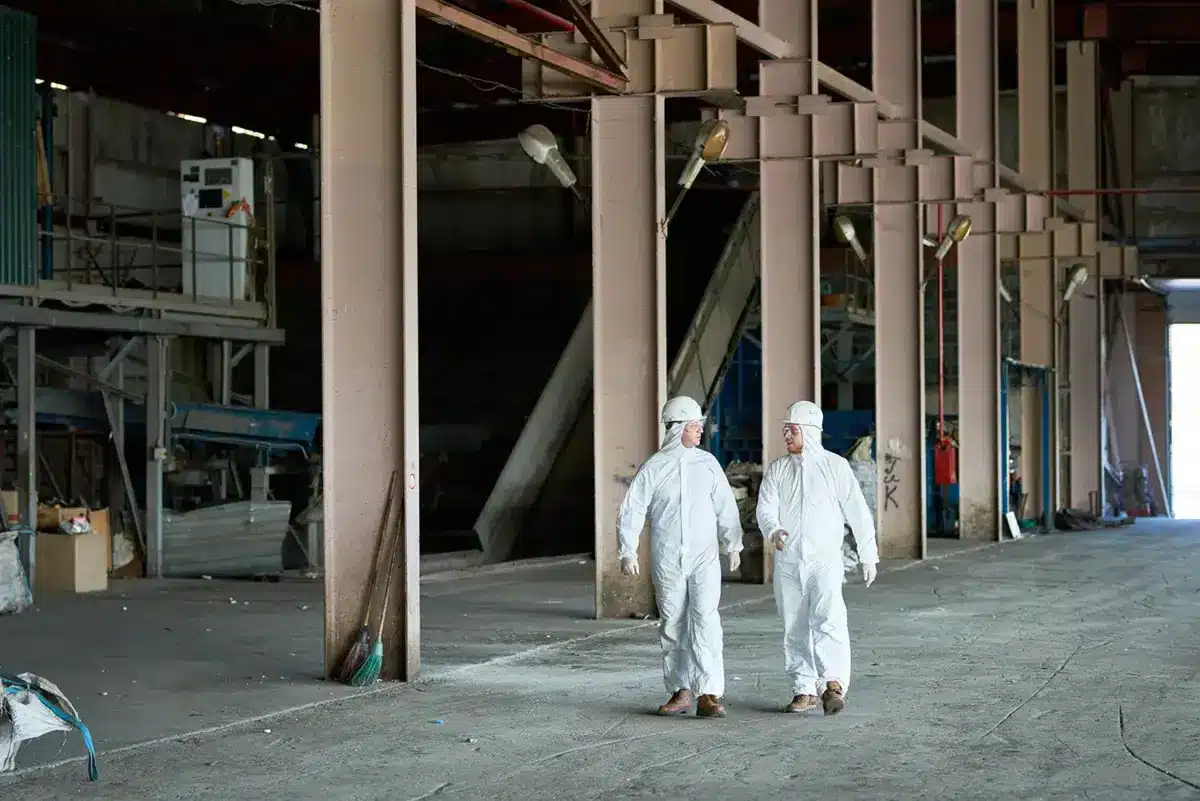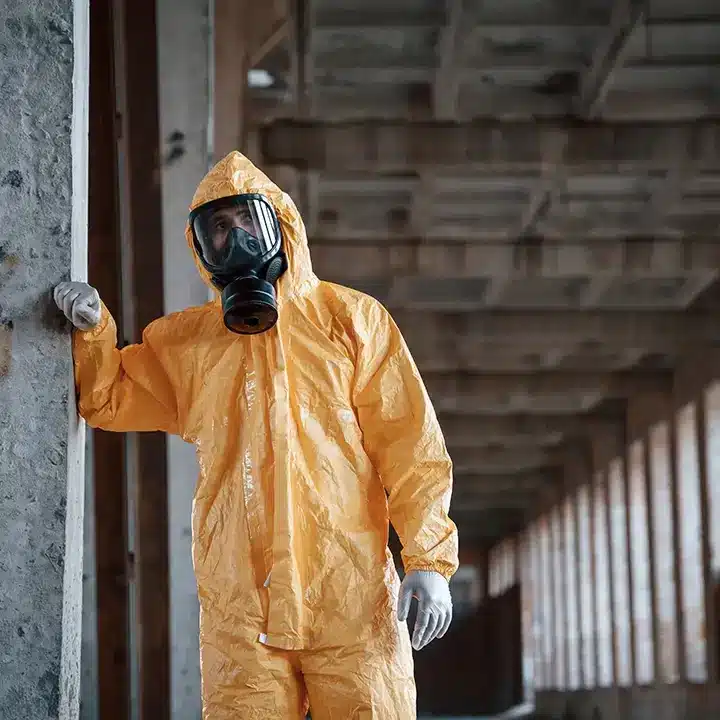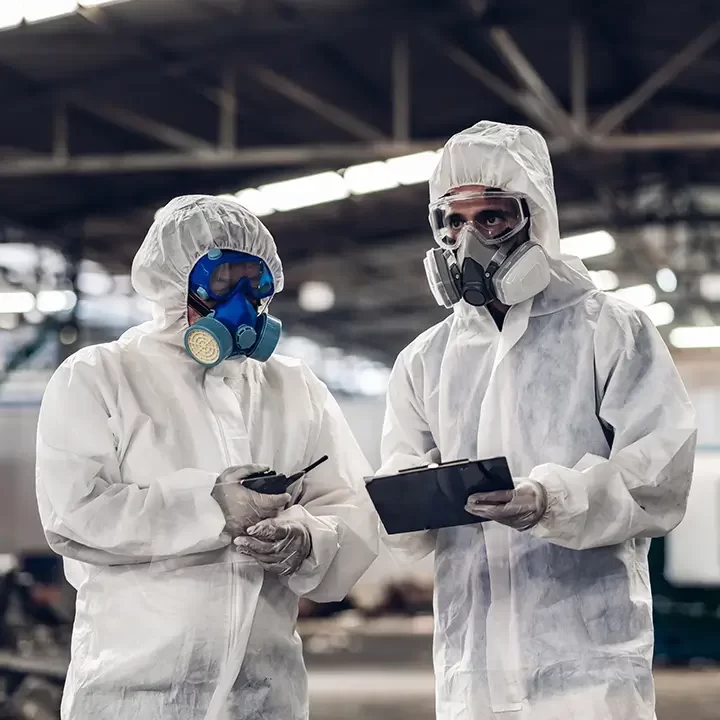
Mould Removal: Should You Handle It or Call a Professional?
September 13, 2024
Unveiling the Hazards: Navigating the Impact of Lead Paint
October 3, 2024Asbestos is a natural mineral that was used in many industries for its fireproof and durable properties. However, the many dangers of asbestos exposure are now well-known, linking it to serious lung diseases like asbestosis, lung cancer, and mesothelioma. Though asbestos is no longer widely used, many old buildings and workplaces still contain it, putting certain jobs at higher risk.
In this blog, we will break down the risks of asbestos exposure based on different jobs, explain the health risks, and show why professional asbestos removal is important to keep you and your family safe.
What is Asbestos Exposure?
Asbestos exposure happens when the fibers in a piece of asbestos are disturbed and get released into the air. When inhaled, these tiny fibers can settle into the lung tissue and stay there for years, leading to serious health risks. Because asbestos-related illnesses often take a long time to develop, many people exposed don’t notice symptoms until decades later.
Common symptoms include:
- Shortness of breath
- Persistent coughing
- Chest pain
- Fatigue
Jobs with the Highest Risk of Asbestos Exposure
Though asbestos use has declined, it is still found in older buildings, ships, and industrial settings. Workers in certain industries are more likely to come into contact with asbestos products, putting them at higher risk of asbestos exposure.
Construction Workers
Many older building materials used in construction, such as floor tiles, insulation, roofing, and drywall, contain asbestos. Construction workers, especially those who perform demolition, renovations, or removal of asbestos, are at high risk of asbestos exposure. When old structures are torn down, asbestos can be disturbed and spread through the air, making it hazardous to workers.
Workers with long-term exposure may develop asbestos-related diseases, such as lung cancer or mesothelioma. Using proper safety measures when working with old materials is critical to reducing the risk of developing serious health problems.
Shipyard Workers
Shipyard workers are also at high risk because asbestos was used in shipbuilding for its heat and fire resistance. Workers who installed or removed asbestos insulation on ships often inhaled high levels of asbestos.
Due to the long-term exposure in shipyards, these workers are unfortunately more likely to develop asbestos-related diseases later in life, such as asbestosis or lung cancer.
Electricians and Plumbers
Electricians and plumbers often work in older buildings where asbestos insulation, pipe wrappings, and electrical insulation are common. These workers are frequently exposed when doing repairs, upgrades, or installations.
The danger is that exposure occurs when the asbestos is unknowingly disturbed. For example, electricians working on wiring in an old building may disrupt asbestos insulation. Plumbers working on older pipes may also face the same issue, putting them at risk of asbestos exposure.

Manufacturing Workers
In the past, many manufacturing plants made products that contained asbestos. Workers who participated in the production of asbestos products, such as brake pads, insulation materials, and gaskets, were often exposed to large amounts of asbestos dust.
Even though asbestos is rarely used in these industries today, former workers may still develop asbestos-related diseases from long-term exposure. In some cases, workers also unknowingly brought asbestos fibers home on their clothing, accidentally putting their family members at risk of exposure.
Firefighters and First Responders
First responders, like firefighters, are at high risk when entering burning or damaged buildings that contain asbestos. Fires and explosions disturb asbestos fibers in building materials, releasing them into the air. As a result, firefighters and other emergency workers face high levels of asbestos exposure when responding to incidents in older buildings.
Because these workers often face multiple exposures over their careers, they have a higher risk factor for developing diseases like asbestosis and lung cancer later in life. This makes proper safety protocols and protective gear essential for first responders working in older buildings.
Health Risks of Asbestos Exposure
The major risk of asbestos exposure is developing serious lung diseases. Common illnesses linked to asbestos exposure include:
- Asbestosis: A chronic lung disease caused by scarring of the lungs due to inhaled asbestos fibers. Symptoms can include shortness of breath, frequent coughing, and chest tightness.
- Mesothelioma: A rare but often aggressive cancer that affects the lining of the lungs or other internal organs. It usually develops decades after exposure.
- Lung Cancer: Asbestos exposure increases the risk of lung cancer, especially for those who also smoke. Asbestos fibers get lodged in lung tissue, leading to cancer over time.
While long-term exposure is the main cause of these illnesses, even brief exposure can lead to health problems in some cases.
How to Protect Yourself from Asbestos Exposure
The Occupational Safety and Health Administration (OSHA) and the Canadian Centre for Occupational Health and Safety (CCOHS) have strict rules to help protect workers from asbestos exposure. Employers must provide protective equipment and ensure workers are trained to handle asbestos safely. Key safety measures include:
- Personal Protective Equipment (PPE): Workers should wear respirators and a protective layer of clothing when working with asbestos-containing materials.
- Air Monitoring: Regular air tests should be done to make sure asbestos levels are safe.
- Training and Education: Workers need to be trained to recognize asbestos and learn how to handle or remove it safely.
If you think you’ve been exposed to asbestos at work, it’s important to talk to your doctor about your medical history and get regular check-ups to detect any asbestos-related diseases early.
Why Professional Asbestos Removal Is Important
Attempting to remove asbestos on your own can be dangerous, as disturbing it may release harmful fibers into the air. Professional asbestos removal companies, like Healthy Environmental, have the expertise and tools to remove asbestos safely. We follow strict regulations to ensure that all asbestos is removed properly and without risk to your health.
Our team at Healthy Environmental provides comprehensive asbestos removal services to keep homes and workplaces safe. If you suspect asbestos is present in your building, it’s essential to have it inspected by licensed professionals before starting any renovations. This ensures your safety, as well as the safety of your family members and workers.
Asbestos in Building Materials: Common Places of Risk
While asbestos is no longer used in new construction, it remains present in many older buildings, especially those built before the 1980s. Common building materials that may potentially contain asbestos include:
- Floor tiles
- Roofing materials
- Drywall and joint compounds
- Insulation
These materials can present a serious health risk if disturbed during renovations or repairs. For this reason, it’s crucial to have any older building materials tested before starting work.
Conclusion
Asbestos exposure remains a significant health risk, particularly for workers in industries where asbestos was commonly used. Understanding the jobs most at risk and the proper safety measures is key to preventing exposure and protecting your health. At Healthy Environmental, we specialize in professional asbestos removal to eliminate these dangers from your environment.
If you’re concerned about asbestos exposure in your home or workplace, contact us today to schedule an inspection and learn how we can help ensure your safety.




